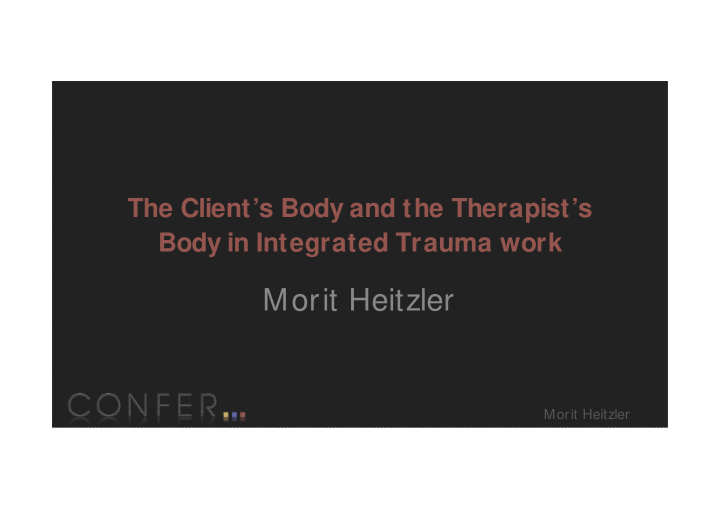



The Client’s Body and the Therapist’s Body in Integrated Trauma work Morit Heitzler Morit Heitzler
The Body of the Traumatised Client Morit Heitzler
Neuroscience has clearly established that trauma and PTSD significantly alters brain function - not only during the traumatic event itself, but also during any re-experiencing of it. Morit Heitzler
Brain stem and limbic System are activated in the mid-brain Morit Heitzler
Functions, such as the ability to •speak •process information on a cognitive level •differentiate between past and present •make sense and find meaning Are unavailable during re-experiencing of the trauma and chronically impaired between episodes of re-traumatisation . Morit Heitzler
How do we work with the body in trauma? Resources Morit Heitzler
A client who presents with PTSD usually has a highly dysregulated bodymind system Morit Heitzler
The concept of the ‘safe place’ Morit Heitzler
This reduces the hyper-arousal in the nervous system returning client to the ‘window of tolerance’ (Siegel,1999). This is the optimal arousal zone in which the autonomic nervous system is regulated Morit Heitzler
Bottom up: body towards mind Morit Heitzler
Through attunement, energetic perception, own right brain and autonomic nervous system responses - what the Boston Change Study Group calls ‘implicit relational knowing - the therapist can monitor the arousal Morit Heitzler
Completing the interrupted impulse Morit Heitzler
The ‘vasomotoric cycle’ is a term coined by Gerda Boyesen in the 1980s Morit Heitzler
The traumatic freeze response blocks the cycle and PTSD can be defined as a chronic parasympathetic lid on top of a sympathetic volcano . Morit Heitzler
Often, in trauma work, the interrupted impulse is buried under the freezing response, and when it is set free, it only then manifests in the fight-or-flight response. Morit Heitzler
W hen the interrupted impulse is identified and being supported to express itself, we often reach what Pat Ogden calls the ‘act of triumph’, the ability to complete the action that was inhibited during the trauma. Morit Heitzler
Combining EM DR with the interrupted impulse Morit Heitzler
Traumatic dysregulation: re-establishing healthy self- regulation Morit Heitzler
Self-regulation: The ability of the organism to regulate itself towards equilibrium, well-being and health Morit Heitzler
Identification with the abuser takes the shape of an internal abuser-victim relationship between mind and body. Morit Heitzler
Self-regulation is learnt through and within the early attachment bond with the mother. It is based on interactive resonances between the mother’s and child’s bodies. Morit Heitzler
The child learns to rely on what Donald Kalsched calls the ‘self-care system’, substituting compulsive modes of care taking and control for what Allan Schore calls ‘healthy auto- regulation’. Morit Heitzler
One of challenges of trauma work is to confront these patterns and to offer a new, unknown experience of the other as the regulatory object. Morit Heitzler
The importance of the therapist’s body Morit Heitzler
Trauma processing requires a container. The therapist creates this container through her energetic embodied presence. Morit Heitzler
For the traumatised client the issue of trust is closely linked to issues of survival, therefore the testing will be more intense and take place also on that primal level of survival. Morit Heitzler
The body of the regulatory object Morit Heitzler
The therapist, like the mother, constitutes the regulatory object that hopefully can contain and digest what the client is still not ready to be aware of. Morit Heitzler
M irror Neurons … …are a mechanism for empathy, but may also be a mechanism for absorbing dissociated trauma. Morit Heitzler
The therapist’s role is to be able to tolerate and regulate their own states of hyper-arousal, dissociation, splitting and despair. Morit Heitzler
To be alert and interested in what it is that is communicated implicitly, via non-verbal expression. Morit Heitzler
The body as one channel for perceiving traumatising relational configurations Morit Heitzler
In developmental trauma, the client often internalises the figures who were involved in the trauma Morit Heitzler
Via somatic projective identification, the client projects and enables the therapist to feel in their body the various bodymind states of those internal parts. Morit Heitzler
Only when the therapist can surrender and accept this powerful somatic counter- transference, and its unconscious communication, can she reflect, think and offer an interaction which is not defensive, but fed by a deep knowing of all the layers of the client’s psyche. Morit Heitzler
Transformative potential through surviving bodymind enactment Morit Heitzler
W hen the therapist is able to embrace the trauma in her own embodied experience, only then can the therapeutic dyad survive the trauma and heal. Morit Heitzler
Recommend
More recommend